The marble floorThe marble mosaics cover the floor of the cathedral and are divided into 56 panels of various sizes and shapes. In addition, they illustrate various techniques from the simplest--holes and lines drilled in marble and then filled with bitumen--to entarsias of multi-colored marbles or gray and white mosaics with additional colored pieces. Most of these were probably executed in the second half of the 14th century. Some of the floor panels have been restored or reconstructed.
|
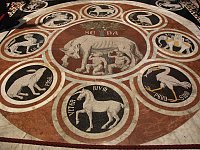
|
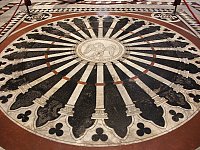
|
Left: The Sienese She Wolf with emblems of 12 confederate cities; |
| |
|
Left: Wheel of Fortune, 1372; center: detail of The History of Fortune or the Hill of Virtue, based on designs by Pinturicchio in 1504 and executed in 1506; right: detail of Massacre of the Innocents by Matteo di Giovanni, 1481
|
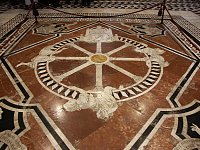
|
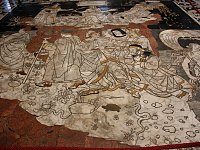
|
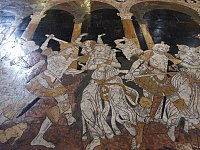
|
| |
|
The Piccolomini Library, begun in 1492Commissioned by the Archbishop of Siena, who later became Pope Pius III, the library was intended to house the manuscript collection belonging to his uncle Pope Pius II as well as to honor this important humanist scholar. Beautiful illuminated manuscripts are opened all along the perimeter of the library. The walls and ceilings are covered with frescoes by Pinturicchio, executed between 1502-1503 and 1505-1507. The scenes on the walls illustrate events in the life of Enea Silvio. Piccolomini, Pope Pius II. |
Center--left panel: Eneo Silvio, Bishop of Siena, who arranged the marriage, presides over the meeting of the betrothed couple, Frederick III and Eleanor of Aragon, and center--right panel: Enea Silvio ordained cardinal; right; whole of the betrothal fresco containing many portraits of contemporary persons |
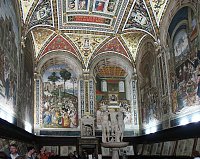
|
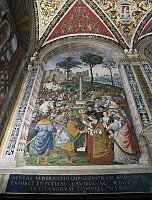
|
| |
|
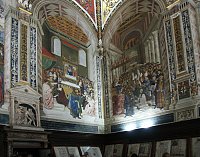
|
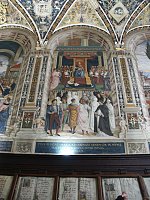
|
Left--left panel: Enea Silvio ordained cardinal and left--right panel: Papal coronation of Pius II; center: the canonization of Saint Catherine of Siena |


 Click here to return to index of art historical sites.
Click here to return to index of art historical sites.
 Click here to return to index of artists and architects.
Click here to return to index of artists and architects.
 Click here to return to chronological index.
Click here to return to chronological index.
 Click here to see the home page of Bluffton University.
Click here to see the home page of Bluffton University.
